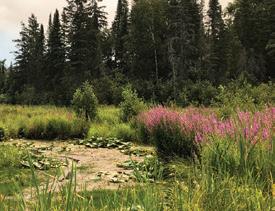
4 minute read
Purple loosestrife—history and environmental impact
Purple loosestrife— history and environmental impact
BY QUINN MILLER, LAKESMART ENVIRONMENTAL STEWARDSHIP TECHNICIAN, LOWDSA
Advertisement
Purple loosestrife (Lythrum salicaria) is an invasive plant species that has a negative impact on ecosystems across North America, including the Lake of the Woods ecosystem. It was brought to North America from its native habitat in Europe when its seeds were present in soil carried on ships, through imported livestock, bedding, and feed, as well as when European settlers planted the flower in their gardens. The plant forms dense mats of roots that choke out native plant species and reduce habitat for native wildlife. With seeds easily spread by water, wind, and human movement, purple loosestrife has become a significant problem for shoreline ecosystems, reducing biodiversity and disrupting ecological balance. This invasive plant thrives in wetlands across North America as it has no natural insect predators.
Habitat and identification
Purple loosestrife can be identified by the woody and distinctly square stems, growing to over two meters in height. The flowers of the plant have five to seven pink/purple petals arranged in groups at the top of the stems. Leaves are arranged on the stem opposite or whorled and are three to ten centimetres long. A single plant can have upwards of 15 stems. Larger plants can produce millions of seeds each season, making the spread of purple loosestrife difficult to control. The plant is typically found in wetlands, shorelines, and along roadside ditches. Its ability to reproduce through plant fragments produce up to two million seeds per growing season and its tolerance to a variety of water and soil conditions contributes to its rapid spread through many environments. The seeds released towards the end of August can lay dormant in the soil of the surrounding area for up to two years, and disruption of the soil can cause dormant seeds to germinate.
Other species of loosestrife are native to the Ontario region. Some species are sold in garden centres and advertised as "sterile"; however, these species can crosspollinate with purple loosestrife, thus producing viable seeds that will contribute to the spread. As an extra precaution, it is advisable to avoid planting any loosestrife varieties in the region.
Initiatives
The eradication and management of purple loosestrife can be difficult as the plant spreads easily through the seeds. To manage purple loosestrife populations on private property, owners can practice hand-cutting the plant, which must be done before the flowers go to seed. However, the plant is incredibly resilient and can easily re-root from pieces of root, stock, seeds, or other small pieces making it hard to get rid of. Furthermore, no herbicides are registered for use in Canada for purple loosestrife growing in or close to water.

While there’s been a slight reduction in the purple loosestrife population in the area, more needs to be done.
The good news
Biological controls such as Neogalerucella beetles, a species also native to the same habitat as purple loosestrife, were approved for use in 1992, and they have been successful in the long-term removal and management of this invasive species. The beetles feed exclusively on purple loosestrife, weakening and eventually causing the death of the plant, all while leaving native species unharmed. The LakeSmart team released Neogalerucella beetles on Coney Island in 2020. This was the fourth beetle release by LOWDSA over the past few years and has shown success in reducing the spread of purple loosestrife on the Lake of the Woods. A return visit to the same Coney Island property in 2021 has shown a slight reduction in the purple loosestrife population but much more still needs to be done.
LOWDSA's LakeSmart team members Abbi Friesen and Brie McCardle executed a hand-cutting day to help reduce the population of Loosestrife on the east side of Coney Island. The property owner, a helpful neighbour, as well as LOWDSA's Assistant Executive Director, Shelley Bujould, assisted in the removal of bags of the invasive plant. The property is being considered as a pilot area for ongoing management.

One of the few ways to manage purple loosestrife populations is hand-cutting the plant, which must be done before the flowers go to seed.
Managing invasive species
If you have purple loosestrife on your property (or any other invasive species), please report it to EDDMaps at eddmaps.org/ Ontario or on their mobile app. EDDMaps is a mapping program to document the population and spread of invasive species. To manage a purple loosestrife population on your property, the best practice is to cut the stems below the flowers and put them in a black garbage bag. The bag should sit out in the sun for at least a day before being taken to the landfill. Alternatively, you can purchase beetles for your property to manage the plant.
The spread of invasive species is exacerbated by the movement of watercrafts from lake to lake. To stop the spread of invasive species, it is important to clean, drain, and dry your watercraft when transporting it to and from water bodies.
For more information about purple loosestrife or any other invasive species, and for any questions, please contact LOWDSA and the LakeSmart team at 1-807-468-8715 (TF 1-807-265-9784) or by emailing info@lowdsa.com.










